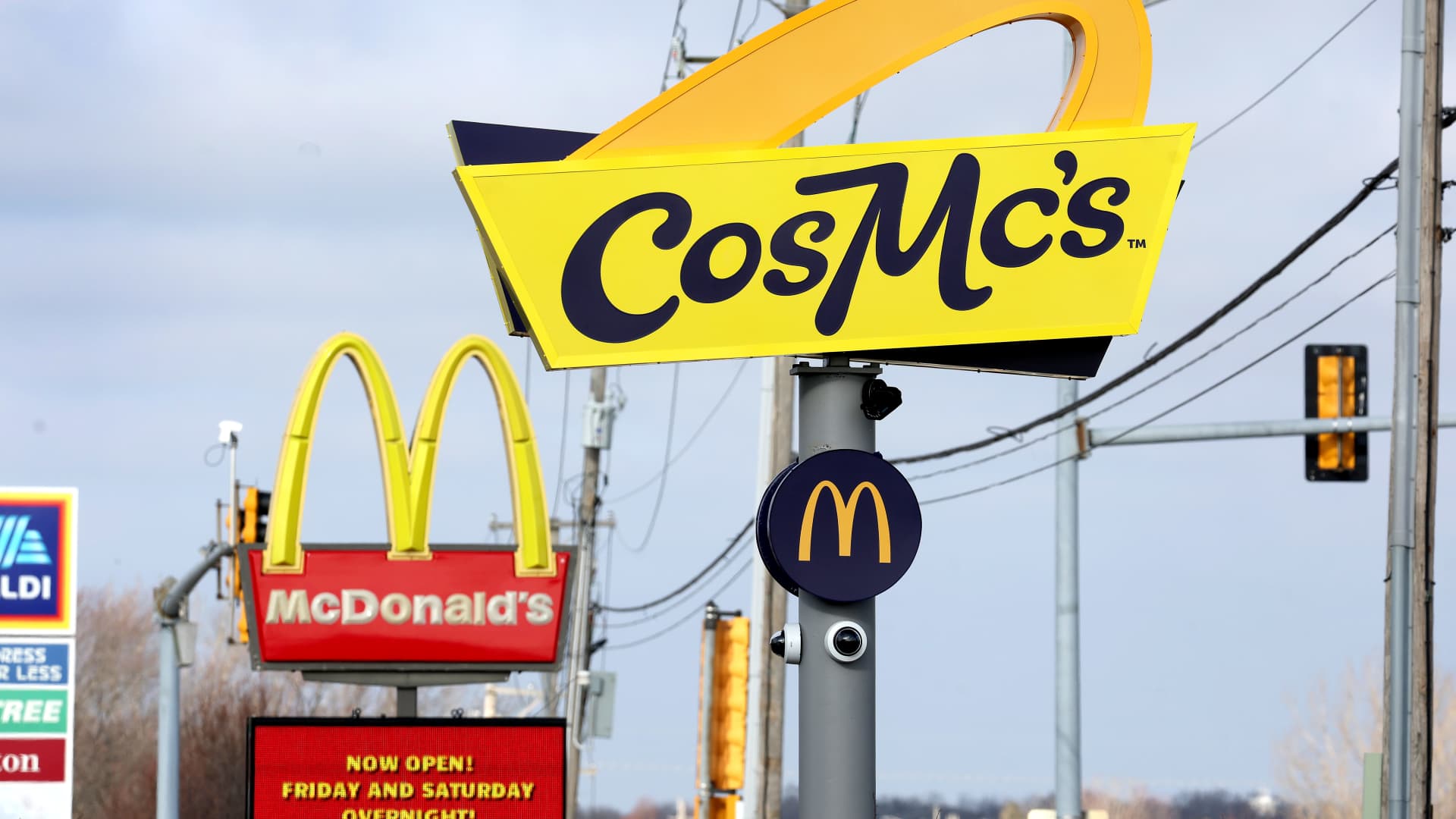Global Trends and Politics
McDonald’s Location Shift

McDonald’s Shuts Down Three Locations of Its Drinks-Focused Spinoff Brand, CosMc’s
McDonald’s will shutter three locations of its drinks-focused spinoff brand, CosMc’s, as it refines its strategy for the concept. The decision comes after a year-long test period, during which the company opened a total of nine CosMc’s locations, including one in the Chicago suburb of Bolingbrook and six in Texas.
Why the Closures?
According to McDonald’s, the smaller prototype locations work better for the test, and as a result, the company will close three of its larger format CosMc’s locations and open two more small Texas restaurants. The locations of the closures and openings have not been disclosed, although a new CosMc’s store is expected to open soon in Allen, Texas.
What’s Working Well?
McDonald’s shared some early learnings from the pilot, including that savory hash browns are the top-selling food item at any time of day, followed by McPops, the chain’s mini filled doughnuts. The best-selling drinks include the Island Pick-Me-Up Punch, Churro Cold Brew Frappe, and the Sour Energy Burst.
The Test Continues
The CosMc’s test will continue for the "foreseeable future," according to McDonald’s. The company created CosMc’s as its entry point into the growing "afternoon beverage pick-me-up occasion."
Menu Highlights
CosMc’s menu features some McDonald’s classics, as well as new items playing off other beverage and snacking trends, such as its iced turmeric spiced lattes, tropical spiceade, and pretzel bites. The brand is positioned as a competitor to other successful beverage chains, including Starbucks, Dutch Bros, and bubble tea chain Kung Fu Tea, which have found success with younger consumers by offering customizable cold drinks.
The Name
The name CosMc’s comes from CosMc, a McDonaldland mascot that appeared in advertisements in the late 1980s and early 1990s. CosMc is an alien from outer space who craves McDonald’s food.
Conclusion
McDonald’s is still evaluating the potential for growth of CosMc’s, but for now, the brand remains a small part of the company’s overall U.S. footprint. With over 13,500 U.S. restaurants, McDonald’s is hoping to learn more about its CosMc’s customers and refine its strategy for the brand.
Frequently Asked Questions
Q: Why is McDonald’s closing CosMc’s locations?
A: McDonald’s is closing three CosMc’s locations as it refines its strategy for the concept.
Q: Why is McDonald’s testing CosMc’s?
A: McDonald’s created CosMc’s as its entry point into the growing "afternoon beverage pick-me-up occasion."
Q: What are the best-selling items at CosMc’s?
A: Savory hash browns and McPops are the top-selling food items, while the Island Pick-Me-Up Punch, Churro Cold Brew Frappe, and the Sour Energy Burst are the best-selling drinks.
Global Trends and Politics
Airport Lounges Becoming Increasingly Exclusive

Introduction to Airport Lounge Access Changes
Airplane tickets are getting cheaper, but it’s getting more expensive to bring your family to an airport lounge. Capital One is the latest company to limit access to booming airport lounges to combat overcrowding.
Changes to Capital One Lounge Access
Starting February 1, Venture X and Venture X Business cardholders will no longer be able to automatically take a guest into lounges or bring authorized second card users. They will instead have to pay $125 annually for each additional cardholder to keep their lounge access, $45 per adult guest per visit, and $25 per guest 17 or younger. The $125 fee also includes second cardholder access to a network of Priority Pass lounges.
Rationale Behind the Changes
According to Capital One, the changes are intended to maintain a great airport lounge experience for Venture X and Venture X Business customers while continuing to deliver best-in-class premium travel cards at an accessible price point. The company stated, "As airport lounges continue to grow in popularity across the industry, we’ve seen our customers increasingly encounter wait times to enter them."
Spending Requirements for Complimentary Guests
Primary cardholders will have to spend at least $75,000 per calendar year to bring up to two complimentary free guests to Capital One lounges and one guest to Capital One Landings, smaller lounges built for travelers who tend to spend less time at the airport, like those heading to short flights. This spending requirement matches what American Express announced two years ago, also a measure to minimize crowding and keep the clubs feeling exclusive.
Credit Card Companies and Airport Lounge Networks
Credit card companies have ramped up their airport lounge networks in recent years, opening new locations to handle demand. And airport lounge access has been a central perk attached to rewards cards, which generally come with an annual fee. The Venture X card, which launched in 2021, is $395 a year, less than the $695 a year American Express charges for its Platinum card or the $550 JPMorgan Chase charges for the Chase Sapphire Reserve, both of which come with airport lounges.
Challenges Faced by Lounge Operators
According to Henry Harteveldt, founder of Atmosphere Research Group, "When it comes to lounges, Capital One is a challenger brand; they’re an underdog." Capital One has lounges at Denver International Airport, Dallas-Fort Worth International Airport, Washington Dulles International Airport, and Harry Reid International Airport in Las Vegas. It plans to open one this year at New York’s John F. Kennedy International Airport and one of its Landings at LaGuardia Airport. However, the new restrictions show that Capital One isn’t immune to its popularity leading to big crowds.
Industry-Wide Changes
Airlines have also raised prices to access airport lounges and built larger ones to accommodate the influx. Delta Air Lines, for example, has made sweeping changes to its lounge access policies, like getting rid of unlimited visits in favor of annual caps. And last summer, Delta unveiled its first Delta One lounge, dedicated to customers in its highest class of cabin. It plans to open a new one in Seattle later this month. American Airlines and United Airlines have also expanded their airport lounges and opened new top-tier ones for customers traveling in premium classes on long-haul flights.
Conclusion
In conclusion, the changes to airport lounge access policies by Capital One and other credit card companies and airlines are intended to combat overcrowding and maintain a high-quality experience for customers. While these changes may be inconvenient for some, they are necessary to ensure that airport lounges remain a valuable perk for premium travelers.
FAQs
Q: What are the changes to Capital One lounge access?
A: Starting February 1, Venture X and Venture X Business cardholders will no longer be able to automatically take a guest into lounges or bring authorized second card users. They will have to pay $125 annually for each additional cardholder to keep their lounge access, $45 per adult guest per visit, and $25 per guest 17 or younger.
Q: Why are these changes being made?
A: The changes are intended to maintain a great airport lounge experience for Venture X and Venture X Business customers while continuing to deliver best-in-class premium travel cards at an accessible price point.
Q: What is the spending requirement for complimentary guests?
A: Primary cardholders will have to spend at least $75,000 per calendar year to bring up to two complimentary free guests to Capital One lounges and one guest to Capital One Landings.
Q: Are other credit card companies and airlines making similar changes?
A: Yes, other credit card companies and airlines are also making changes to their lounge access policies to combat overcrowding and maintain a high-quality experience for customers.
Global Trends and Politics
Walmart Expands Drone Deliveries to More States

Introduction to Walmart’s Drone Deliveries
Walmart is bringing drone deliveries to three more states. On Thursday, the big-box retailer said it plans to launch the speedier delivery option at 100 stores in Atlanta, Charlotte, Houston, Orlando, and Tampa within the coming year. With the expansion, Walmart’s drone deliveries will be available in a total of five states: Arkansas, Florida, Georgia, North Carolina, and Texas.
How Drone Deliveries Work
Customers will request a delivery through the app of Wing, the operator who flies the drones through a deal with Walmart. The drone operator will have an up to a six-mile range from stores. Drone deliveries are one of the buzziest examples of Walmart’s efforts to compete with rivals like Amazon on convenience along with low price.
Walmart’s Efforts to Compete with Amazon
With more than 4,600 Walmart stores across the U.S., the retailer has used its large footprint to get online orders to customers faster. It has an Express Delivery service that drops purchases at customers’ doors in as fast as 30 minutes, along with InHome, a subscription-based service, that puts items directly into people’s fridges. The company began same-day prescription deliveries last fall and has expanded the service across the country.
Customer Feedback and Demand
"The number one piece of feedback that we get from our customers are, ‘When are you expanding?’" said Greg Cathey, senior vice president of Walmart U.S. transformation and innovation, referring to drone delivery. Cathey said shoppers using the drone service typically order urgent items, such as hamburger buns for a cookout, eggs to make brownies or Tylenol or cold medicine needed when sick.
Delivery Time and Items
Drone deliveries take 30 minutes or less, the company said. So far, some of the most frequently delivered items include eggs, ice cream, pet food, and fresh fruit, including bananas, lemons, and eggs, Walmart added. Walmart stores have an assortment of over 150,000 items in a location. Over 50% of those can be delivered by drone, Cathey said.
Challenges and Setbacks
Yet the rollout of speedy deliveries across the U.S. has come with stops and starts. Three years ago, Walmart announced a plan to expand drone deliveries with DroneUp so it would be able to reach 4 million households across six states fulfilled from 37 stores in parts of Arizona, Arkansas, Florida, Texas, Utah, and Virginia. At the time, the company’s leaders said the retailer would be able to deliver over 1 million packages by drone in a year by using those sites. The rollout never stuck.
Current Progress and Comparison to Amazon
Walmart’s drone delivery count so far is modest. The company did not share the specific count, but said it has racked up a total of more than 150,000 drone deliveries since 2021. Chief competitor Amazon’s expansion of drone deliveries has been slow-going, too. The e-commerce giant set a goal to deliver 500 million packages by drone per year by the end of the decade through its service, Prime Air.
Testing and Expansion
Walmart has tested drone deliveries in Northwest Arkansas, near its hometown of Bentonville, and scaled them to reach most of the population in the Dallas-Forth Worth area. Several drone operators, including Zipline, Flytrex, DroneUp, and Wing, have powered Walmart’s deliveries, but the retailer has not provided the financial terms of the deals or the amount of money it has made from sales delivered by drones.
Future Plans and Goals
Kieran Shanahan, chief operating officer of Walmart U.S., said the company wants to offer "flexibility and convenience" with drones, along with speedier deliveries by van. "We see it as part of a broader ecosystem of things," he said. "And who knows what five years, 10 years time will bring as new technologies and capabilities unlock?"
Conclusion
Walmart’s expansion of drone deliveries is a significant step towards competing with Amazon and providing faster and more convenient delivery options to its customers. While there have been setbacks and challenges, the company remains committed to its goal of providing speedy and flexible delivery options.
FAQs
Q: What states will Walmart’s drone deliveries be available in?
A: Walmart’s drone deliveries will be available in a total of five states: Arkansas, Florida, Georgia, North Carolina, and Texas.
Q: How do customers request drone deliveries?
A: Customers will request a delivery through the app of Wing, the operator who flies the drones through a deal with Walmart.
Q: What is the delivery time for drone deliveries?
A: Drone deliveries take 30 minutes or less.
Q: What items are most frequently delivered by drone?
A: Some of the most frequently delivered items include eggs, ice cream, pet food, and fresh fruit.
Q: How many items can be delivered by drone?
A: Over 50% of the 150,000 items in a Walmart store can be delivered by drone.
Global Trends and Politics
Used Vehicle Prices Decrease

Introduction to Used Vehicle Prices
A Ford Mustang is seen at a used car dealership in Montebello, California on May 5, 2025.
Frederic J. Brown | AFP | Getty Images
DETROIT — Used vehicle prices last month eased from their recent high in April as consumers who may have needed a vehicle but feared price hikes due to tariffs flocked to purchase a car or truck, according to a closely watched barometer of preowned prices.
Used Vehicle Value Index
Cox Automotive’s Manheim Used Vehicle Value Index — which tracks prices of used vehicles sold at its U.S. wholesale auctions — decreased 1.5% from April to May, but remained 4% higher than a year earlier. April’s level was the highest since October 2023.
"Wholesale appreciation trends were remarkably strong in April, but the market gave some of that strength back in May, though values remain well above last year’s levels," said Jeremy Robb, senior director of economic and industry insights at Cox Automotive.
Impact on Retail Prices
Retail prices for consumers traditionally follow changes in wholesale prices, but they have not fallen as quickly as wholesale prices in recent years.
While President Donald Trump’s tariffs of 25% on new imported vehicles and many parts do not directly impact used car sales, changes in new vehicle prices, production and demand affect the used car market, which is how the majority of Americans purchase a vehicle.
Demand and Inventory Levels
Demand has stayed relatively strong as inventory levels for used vehicles – 2.2 million – remain low compared with historical levels. That comes as consumers have been holding on to their vehicles for longer and as the industry deals with less production in recent years amid the coronavirus pandemic and global supply chain shortages.
Cox reports retail used vehicle sales in May were down 3% compared with April but higher year over year by 4%.
Stabilization of Used Vehicle Prices
Cox previously said it was seeing used vehicle prices continue to stabilize after swinging wildly for several years before starting to calm down in 2024.
Conclusion
In conclusion, used vehicle prices have eased from their recent high in April, but remain higher than last year’s levels. The market is expected to continue stabilizing, with demand staying relatively strong and inventory levels remaining low.
FAQs
Q: What is the current trend in used vehicle prices?
A: Used vehicle prices have eased from their recent high in April, but remain 4% higher than a year earlier.
Q: What is the Manheim Used Vehicle Value Index?
A: The Manheim Used Vehicle Value Index is a closely watched barometer of preowned prices that tracks prices of used vehicles sold at wholesale auctions.
Q: How do tariffs on new imported vehicles affect the used car market?
A: Tariffs on new imported vehicles do not directly impact used car sales, but changes in new vehicle prices, production, and demand can affect the used car market.
Q: What is the current demand for used vehicles?
A: Demand for used vehicles has stayed relatively strong, with retail used vehicle sales in May down 3% compared with April but higher year over year by 4%.
-

 Career Advice6 months ago
Career Advice6 months agoInterview with Dr. Kristy K. Taylor, WORxK Global News Magazine Founder
-

 Diversity and Inclusion (DEIA)6 months ago
Diversity and Inclusion (DEIA)6 months agoSarah Herrlinger Talks AirPods Pro Hearing Aid
-

 Career Advice6 months ago
Career Advice6 months agoNetWork Your Way to Success: Top Tips for Maximizing Your Professional Network
-

 Changemaker Interviews5 months ago
Changemaker Interviews5 months agoUnlocking Human Potential: Kim Groshek’s Journey to Transforming Leadership and Stress Resilience
-

 Diversity and Inclusion (DEIA)6 months ago
Diversity and Inclusion (DEIA)6 months agoThe Power of Belonging: Why Feeling Accepted Matters in the Workplace
-

 Global Trends and Politics6 months ago
Global Trends and Politics6 months agoHealth-care stocks fall after Warren PBM bill, Brian Thompson shooting
-

 Global Trends and Politics6 months ago
Global Trends and Politics6 months agoUnionization Goes Mainstream: How the Changing Workforce is Driving Demand for Collective Bargaining
-

 Training and Development6 months ago
Training and Development6 months agoLevel Up: How Upskilling Can Help You Stay Ahead of the Curve in a Rapidly Changing Industry









